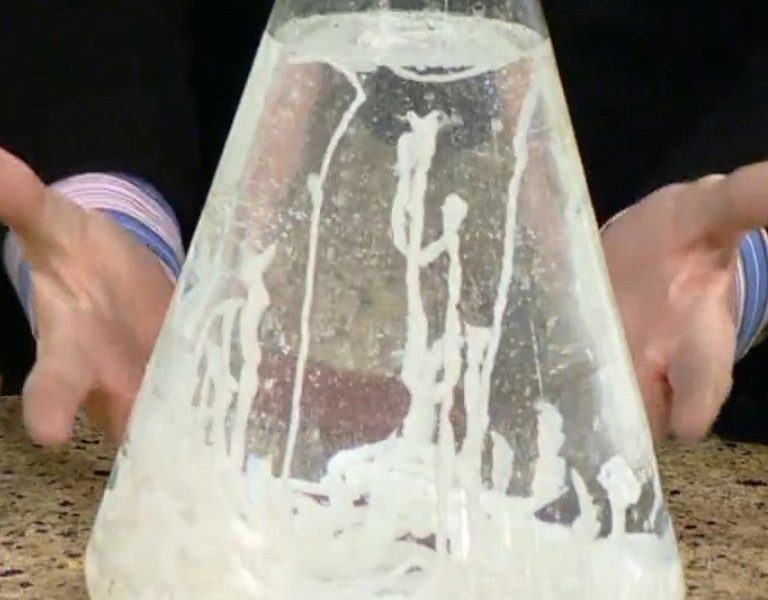Heat Sensitive Worms
There’s nothing better than having a bowl full of worms without the hassle of digging them out of the ground… and all by using fascinating […]

Acid reflux disease is battled by a change in diet, or by using antacids, such as Gavison. In this demonstration, a 250 mL flask is used to model the stomach and to show how the sodium alginate in the product Gaviscon reacts with the acid in the stomach to form a barrier or “raft” which forms a barrier between the oesophagus and excess acid in the stomach. This raft helps keep all the components of the stomach contents in the stomach where they work, not letting them seep back up into the oesophagus where they hurt.
The version of the experiment is described using a small flask (250 mL). The large-scale version presented by Steve Spangler for television used a 5L flask. If you’re wishing to do the large version, just adjust the proportions as needed.
Fill a 250 mL Erlenmeyer flask with 200 mL of a 1M solution of hydrochloric acid.
Add 50 mL of Gavison liquid to the flask.
Almost immediately, you will observe bubbles being formed inside of the flask. These bubbles attach to the worm-like material formed at the bottom of the flask. The “worms” rise to the top of the liquid and form a raft that floats on top of the water. The body of the flask represents the stomach, the neck of the flask the oesophagus and the acid the stomach contents. Notice how the raft forms a barrier between the acid in the stomach and the oesophagus.
**Demonstrator Notes: How to make a 1M solution of HCl
Add 30mL of concentrated HCl (12M) to 220mL of water. This must be done following all safety procedures, under a fume hood and wearing protective gloves and glasses.
Gaviscon contains a substance called sodium alginate, a polymer which can be extracted from brown seaweed and kelps. It is one of the structural polymers that help to build the cell walls of these plants. It has some unusual properties and a wide variety of uses like those found in this experiment.
The Gaviscon initially sinks to the bottom of the flask where a gel forms on contact with the acid. Over a period of a minute or two bubbles of carbon dioxide gas can be seen forming on the surface of the Gaviscon and these carry layers of the gel to the surface of the acid where they form a plug in the neck of the flask. After about five minutes a plug of gelatinous foam will have formed which blocks the neck of the flask and which may rise out of its mouth. At this stage the flask may be inverted (over a sink) and the plug will remain in place holding in the contents of the flask.
But how do those “worms” really form. Steve Spangler Science creates a product called Insta-Worms that turns a liquid containing sodium alginate into long worms when the liquid comes in contact with a solution of calcium chloride. When sodium alginate is put into a solution of calcium ions, the calcium ions replace the sodium ions in the polymer and the long strands “cross-link” to form the worms. Learn more about Insta-Worms.
Once the alginate raft has been produced, it will not remain in the stomach indefinitely. It is largely broken up mechanically by the action of stomach contractions.
Your stomach is basically a big bag. It contains hydrochloric acid that has three main functions. The first function is to help to kill bacteria that may be in our food. The second is to break down our food. The third function is to create the right conditions for a stomach enzyme, called pepsin, to work. The movement, or churning, of the stomach, together with the action of acid and enzymes, breaks the food down into a liquid. The nutrients in the liquid can then be extracted further down our digestive systems within our intestines. Although the role of stomach acids is very important, it may potentially cause problems on occasions, for instance if there is excess acid, and/or if the acid passes out of the stomach upwards (refluxes) into the food pipe.
After the experiments the plug (and the acid) may be washed down the sink with hot water, the plug having been broken up with a test tube brush. With larger quantities, resulting from a class experiment, it may be worth sieving off the gel and disposing of it with the solid waste to avoid the possibility of blocked sinks.